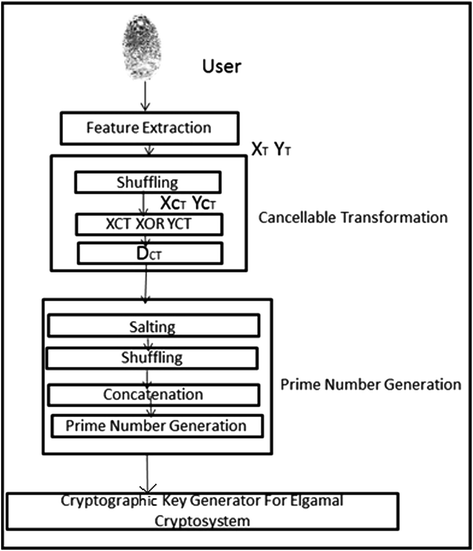- W. Stallings, Cryptography and Network Security: Principles and Practice, 5th edition, Prentice Hall, 2010.Google Scholar
- Soutar, C.; Roberge, A. and Vijaya Kumar, B.V.K., “Biometric Encryption using Image Processing”, SPIE, pp. 178–188, 1998.Google Scholar
- Bolle, R.M.; Connel, J.H. and Ratha, N.K., “Biometrics Perils and Patches”, Elsevier - Pattern Recognition 35, pp. 2727–2738, 2002.Google Scholar
- Teoh, Andrew B.J.; Goh, A. and Ngo, D.C.L., “Random MultispaceQuantisation as an Analytic Mechanism for BioHashing of Biometric and Random Identity Inputs”, IEEE Transactions on Pattern Analysis and Machine Intelligence 28(12), pp. 1892–1901, 2006.Google Scholar
- Ratha, N.K.; Chikkerur, S.; Connell, J.H. and Bolle, R.M., “Generating Cancelable Fingerprint Templates”, IEEE Transactions on Pattern Analysis and Machine Intelligence, 29(4), pp. 561–572, 2007.Google Scholar
- Tulyakov, S.; Farooq, F. and Govindaraju, V., “Symmetric Hash Functions for Fingerprint Minutiae”, International Workshop on Pattern Recognition for Crime Prevention, Security and Surveillance (ICAPR 2005), 3687, pp. 30–38, 2005.Google Scholar
- Ang, R.; Rei, S.N. and McAven, L., “Cancelable Key-Based Fingerprint Templates”, Information Security and Privacy: 10th Australasian Conference (ACISP 2005), pp. 242–252, 2005.Google Scholar
- Maiorana, E.; Campisi, P.; Fierrez, J. and Ortega-Garcia, J., “Cancelable Templates for Sequence Based Biometrics with Application to On-line Signature Recognition”, IEEE Transactions on Systems, 40(3), pp. 525–538, 2010.Google Scholar
- Nanni, L. and Lumini, A., “Cancelable Biometrics: Problems and Solutions for Improving Accuracy”, NovaPublisher - Biometrics: Methods, Applications and Analysis, chap-7, pp. 153–166, 2010.Google Scholar
- F Monrose, MK Reiter, Q Li, S Wetzel, “Cryptographic key generation from voice”, Proceedings of IEEE Symposium on Security and Privacy, pp. 202–213, 2011.Google Scholar
- H Feng, CC Wah, “Private Key generation from on-line hand written signatures”, Information Management & Computer Security, 10(4), pp. 159–164, 2002.Google Scholar
- B Chen, V Chandran, “Biometric Based Cryptographic Key Generation from Faces”, Proceedings of 9th Biennial Conference of the Australian Pattern Recognition Society on Digital Image Computing Techniques and Applications, pp. 394–401, 2007.Google Scholar
- A Jagadeesan, K Duraiswamy, “Secured Cryptographic Key Generationfrom Multimodal Biometrics: Feature Level Fusion of Fingerprint and Iris”, Int. Journalon Computer Sc. & Information Security, 7(2), pp. 28–37, 2010.Google Scholar
- A Jagadeesan, T Thillaikkarasi, K Duraiswamy, “Cryptographic KeyGeneration from Multiple Biometrics Modalities: Fusing Minutiae with Iris Feature”, Int. J. Comput. Appl. 2(6), pp. 16–26, 2010.Google Scholar
- C Rathgeb, A Uhl., “Context-based biometric key generation for Iris”, IET Computer Vision, 5(6), pp. 389–397, 2011.Google Scholar
- D. Milao Q. Tang, and W. Fu, “Fingerprint minutia extraction based on principal curves,” Pattern Recognition Letters, Vol. 28, Issue 16, pp. 2184–2189, 2009.Google Scholar

Cryptographic Key Generation Using Biometrics Test

Key Generation Software

Biometrics gives a lot of methods in high-secure applications while using natural, user-friendly and fast authentication. Cryptography is intended to ensure the secrecy and authenticity of message. Generating cryptographic keys from biometric modalities and multimodal biometrics based user authentication. Recently, among researchers, a great deal of attention have been received on developing approaches for cryptographic key generation from biometric features and authenticating users by combining multiple.